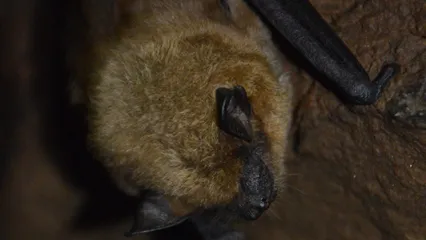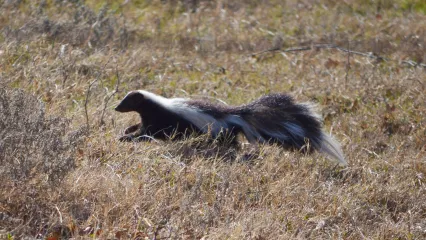
Description
True to its name, the big brown bat is a relatively large, brown bat. These bats tend to have glossy chestnut brown fur on the back, with paler brown hair on the underside. The wings, tail, ears and nose are dark brown to black. In hand, the bat’s forearm measures more than 1.5 inches. The calcar, a cartilaginous extension of the ankle, has a distinct projection, or keel.
Size
Big brown bats have a wingspan of 13 – 16 inches and a total length of 3.5 – 5.25 inches. As in many species of bats, female big brown bats are larger than the males.
Habitat
In winter months, this bat is most often found hibernating in large dry caves and mines with a relatively high amount of airflow. The presence of big brown bats in Oklahoma seems to be limited by the availability of these hibernating conditions. Though they may form small clusters, hibernating big brown bats are typically found singly, nestled in crevices with both their back and belly touching a rock surface. During the rest of the year, big brown bats roost in caves, tunnels, trees cavities, wood piles and bat boxes. Big brown bats are one of eight species of Oklahoma bats known to use bat boxes.
Life Cycle
Like all other Oklahoma bats, big brown bats are insectivores. These bats have large, powerful jaws and regularly feed on larger, hard-shelled beetles and true bugs, but may also feed on moths and leafhoppers. Big brown bats mate in the fall, but fertilization doesn’t occur until the bats emerge in the spring. Females then form nursery groups and give birth to 1 – 2 pups in May. Pups are able to fly about four weeks after birth.
How To Observe
Big brown bats take flight about 20 minutes after sunset. Their flight appears slow and deliberate. They may fly near the roost before flying off to feed. Find more information in the Wildlife Department's "Bats of Oklahoma Field Guide."


